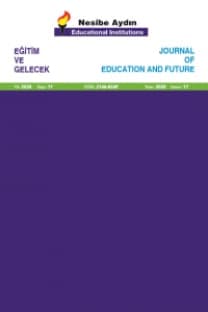How to Transform Language Education for Next Generation Learners: A Path to Follow in Higher Education in the 21st Century
teknoloji, yeni nesil öğrenciler, etkileşim, eğitim ve öğrenme stratejileri, 21.yüzyıl
How to Transform Language Education for Next Generation Learners: A Path to Follow in Higher Education in the 21st Century
technology, next generation learners (NGL), interactive, teaching and learning strategies, collaboration,
___
- Abdous, M.,Camarena, M.M., & Facer, B.R. (2009). MALL technology: Use of academic podcasting in the foreign language classroom. ReCALL, 21(1), 76-95.
- Bennett, R. E. (1999). Article first published online: 25 OCT 2005. Retrieved from http://search.ets.org/researcher/query.html?col=rsrchr&op0=&fl0=AU%3A&ty0=p&tx0=Bennett,+Randy+Elliot&qt=+&st=41
- Berk, R. A. (2009). Teaching strategies for the net generation, transformative dialogue: Teaching & Learning Journal, 3, 25-48.
- Berk, R. A. 2009). Multimedia teaching with video clips: TV, movies,YouTube, and mtvU in the college classroom. International Journal on Technology in Teaching and Learning. 5(1),1-21.
- Berk, R. A. (2011). No teacher left behind: Teaching strategies for the next generation, transformative dialogues, Teaching and Learning Journal, 3(2),1-23. http://images.pearsonassessments.com/images/NES_Publications/2011_09Berk.pdf
- Berenson, S. K. (2009). Educating Millenial Law Students for Public Obligation, Charlotte L. Rev. 51, 53.
- Blickenstorfer, C. (2005). ‘A Brief History of Tablet PCs’, WebProNews, Retriewed 23 April 2015, http://www.webpronews.com/expertarticles/2005/12/20/a-brief-history-oftablet-pdf
- Brown, J. S. (2005). Learning in a digital age. Retrieved from https://www.certiport.com/Portal/Common/DocumentLibrary/IEAB_Whitepaper040808.pdf
- Brown, V. (2007). The power of PowerPoint: is it in the user or the program? Childhood Education, 83.4, 231(3), (online journal Galegroup).
- Calkins, A., Vogt, K., Next Generation Learning Challenges, EDUCAUSE. Retrieved from www.educause.edu http://creativecommons.orglicenses(by-nc-nd/3.0/), Retrieved on 15 April 2015.
- Carlson, J. F. (2005). Preparing an effective syllabus. College Teaching Fall, 53 (4), 159-164.
- Corbell, J.R., Corbell, M.E.V. (2007). Are you ready for mobile learning? Educause Quarterly 2, p.57.
- Cornelius –White, J.( 2007). Learner-centered teacher-student relationships are effective: A meta-analysis. Review of Educational Research, 77, 113-43.
- Gardiner, L. (1998). Why we must change: The research evidence. NEA Higher Education Journal, Spring: 71-88.
- Godfrey, C. (2005). Computers in schools: From machines to thinking tools, Quick, 95,3- 6.
- Heritage, M. (2010). Formative assessment and next-generation systems: Are we losing an opportunity? Los Angeles: National Center for Research on Evaluation, Standards, and Student Testing (CRESST). Retrieved from file:///C:/Users/asus_/Downloads/formative_assessment_next_generation_2010.pdf
- Howe, N. & Strauss, W. (2000). Millennials rising: The next great generation. New York: Vintage Books.
- Hunt, J. E., & Tucciarone, J. (2011). The Challenges and Opportunities of Teaching “Generation Y”, J Grad Med Educ. 3(4), 458–461. Retrieved from http://www.ncbi.nlm.nih.gov/pmc/articles/PMC3244307/
- Kaplan, B. & Darvil, K. (2011). Think (and practice) like a lawyer; legal research for the new millennials, 8 Legal Communication and Rhetoric: JAWLD 153. http://www.law.nyu.edu/sites/default/files/upload_documents/Benfer-Shanahan%20-%20Educating%20Invincibles.pdf
- Milli Eğitim Bakanlığı. (2012). Milli Eğitim Bakanlığı, Milli Eğitim bakanlığı istatistikleri. http://sgb.meb.gov.tr/istatistik/meb_istatistikleri_orgun_egitim_2011_2012.pdf , 20 April 2015.
- Milli Eğitim Bakanlığı. (2012). Milli Eğitim Bakanlığı, Milli Eğitim bakanlığı istatistikleri. http://sgb.meb.gov.tr/istatistik/meb_istatistikleri_orgun_egitim_2011_2012.pdf , 20 April 2015.
- Milli Eğitim Bakanlığı. (2012). Milli Eğitim Bakanlığı, FATİH Projesi. http://fatihprojesi.meb.gov.tr, 20 April 2015.
- Munzur, Z. (2013). Technology is our friend: Using technology to teach english learning strategies, Journal of Education and Future, 4, 51-64.
- National Research Council https://www.certiport.com/Portal/Common/DocumentLibrary/IEAB_Whitepaper040808.pdf
- Niess, M. (2005). Preparing teachers to teach science and mathematics with technology: Developing a technology pedagogical content knowledge. Teaching and Teacher Education, 21, 509-523. Online Journal Elsevier. Retrieved from http://monash.edu/eeducation/assets/documents/atiec/2009/2009atiec-nadineadams-clintonhayes.pdf
- Oblinger, D. (2005). Learners, learning and technology: The Educause learning initiative. Educause Review, 40, 66-75.
- Pernsky, M. (2001). Digital natives, digital immigrants. On the Horizon, 9 (5), 1-6. Pernsky, http://www.marcpernsky.com/writing/default.asp>.
- Tzeng, S. (2011). Teach Only When Understanding: The strategies of teaching industrial design to the net generation. The Online Journal of New Horizons in Education, 1(2), 39.
- Skiba, D. J., Barton, A. J. (2006). Adapting your teaching to accommodate the next generation of learners. OJIN: The Online Journal of Issues in Nursing. 11, (2),
- Tapscott, D. (1998). Growing up Digital: The rise of the net generation. New York: McGraw-Hill.
- Victoria, J. R., Ulla, G. F., Donald, F. R. (2010). Generation m2 media in the lives of 8-18 year olds, A Kaiser Family Foundation Study, Menlo Park, California, USA. http://files.eric.ed.gov/fulltext/ED527859.pdf
- Vavoula, G. (2005). A Study of Mobile Learning Practices, pp.1-20. Retrieved from http://www.mobilelearn.org/download/results/public_deliverables/MOBIlearn_D4.4_Final.pdf
- Web pages
- The Council of Chief State Officers, CCSSO, www.ccsso.org
- Institude of Corporate Directors (ICD) 2012. https://www.icd.ca/Courses/Directors-Education-Program.aspx
- US Department of Education, Understanding the Implications of Online Learning for Educational Productivity, 2012.
- http://tech.ed.gov/files/2013/10/implications-online-learning.pdf
- htttp://siteresources.worldbank.org/DEVMARKETPLACE/Resources/Handout_TheLearningPyramid.pdf
- ISSN: 2146-8249
- Yayın Aralığı: 1
- Başlangıç: 2012
- Yayıncı: Nesibe Aydın Eğitim Kurumları
Discussion on the Concept of Visual Culture at Museum within Postmodern Art Education
Style Approaches in Composition Education: Twelve Tone Technique and Analysis
Why should Speech Rate (Tempo) be Integrated into Pronunciation Teaching Curriculum?
Ekaterina Strekalova-Hughes* Saoussan Maarouf** Burhanettin Keskin
Ekaterina STREKALOVA-HUGHES, Saoussan MAAROUF, Burhanettin KESKİN
Evaluation of an in-Service Training Program Developed about Measurement and Evaluation
Senar ALKIN-ŞAHİN, Nihal TUNCA, Fatih KEZER
1960-1970 Period Yozgat High School Graduates: Our Teachers
Erken Çocukluk Döneminde Öz-Düzenleme Becerilerinin Desteklenmesi: Zihnin Araçları Programı
